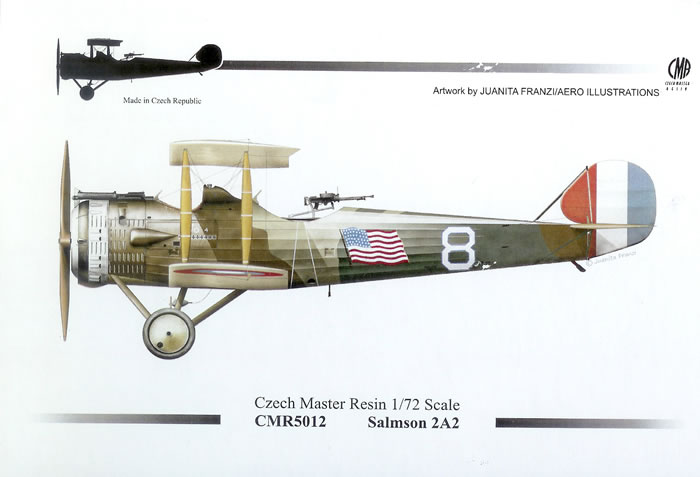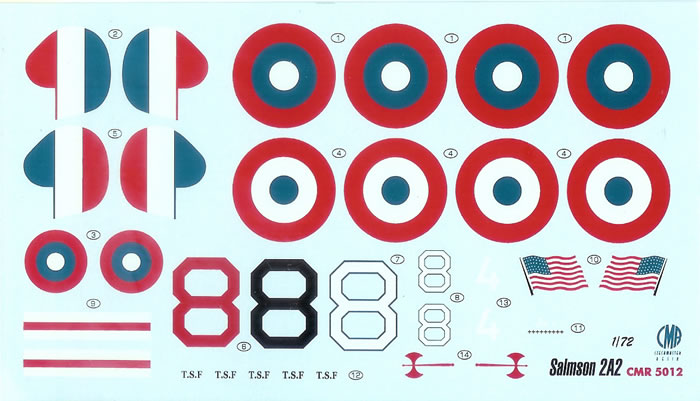|
Salmson 2A2

Czech Master Resin, 1/72 scale
S u m m a r y : |
Catalogue Number: |
Czech Master Resin Kit No. 5012 - Salmson 2A2 |
Scale: |
1/72 |
Contents & Media |
52 x cream resin airframe parts, 3 x black undercarriage struts & braces. Decals for 3 colour schemes. |
Price: |
Available online from Hannants for £26.30, Westcoast Hobbys for C$35.00, Red Roo Models for Au$37.45 and various other CMR stockists. |
Review Type: |
First Look |
Advantages: |
Very well cast parts, should be a conventional and straightforward biplane build. |
Disadvantages: |
Modest levels interior detail. |
Conclusions: |
A well executed kit, and in interesting addition for builders of WW1 types. It looks to be a straightforward build for a WW1 biplane. |
Reviewed
by Mark Davies

HyperScale is proudly supported by Squadron.com
The French Salmson Company built Sopwith 1½ Strutters under licence before exploiting this experience to design an airframe to use the Salmson-built Canton-Unne radial engine offering 230-260 horsepower.
In fact it is the engine that is of particular interest in the case of this aircraft, as it was a water-cooled radial. The radial layout offered benefits of compactness without the severe gyroscopic forces imparted by the more powerful examples of rotary engines popular at the time. I seem to recall reading that water-cooling of radials was used early on because reliable air-cooling of cylinder heads on static rather than rotary engines was problematic. Post-war these problems were surmounted and air-cooling of radials became the norm.
Designed in 1926, the 2A2 prototype first flew in April 1917, and began entering service use towards the end of that year. It turned out to be one of France’s best reconnaissance and light bomber designs, proving to have good endurance and robustness that aircrews came to appreciate when it came to getting home after receiving battle damage. Over 3,2000 2A2’s were built, of which Latécoère, Hanriot, and Desfontaines made 1,000. A few machines were produced as two-seat trainers. This latter role may have been less than ideal, as communication between the two cockpits was difficult due to the distance they were apart.
The USA purchased 705 2A2’s, and 557 of these saw frontline service with US Forces in WW1, making it their most numerous reconnaissance aircraft at the time. Post war Japan produced some under licence as the Otsu 1.
I’m unaware of previous 1/72 kits of the Salmson, but no doubt there have been some. The kit reviewed here re-issue of an earlier CMR release dating back almost 30 years. CMR have used the same masters as the earlier kit, but updated the casting technology used to provide parts equal in quality to CMR’s best practice, along with a new boxing, superior instructions and decals etc.
The contents come in a robust top opening box, with attractive box art by Juanita Franzi of Aero Illustrations (whose work may be familiar to some). All of the contents are sealed in a plastic bag, within which the parts are further sealed in various plastic pockets. Instructions are very clear and well produced. They include scale plans, a rigging diagram and with a colours & markings guide. Colour call outs are generic in description, but include Metheun and Pantone colour codes.
The parts are clean and extremely well cast with no sign of pinholes or other flaws evident. Small easy to remove casting blocks mean that all parts should be ready for use after a few minutes of clean up. The airframe parts capture the look of the fabric-covered structure very nicely, and are set off by the interesting cowl and radiator set-up. The parts breakdown is completely conventional for a medium sized biplane. The undercarriage legs and bracing struts are cast in a black resin which has better load-bearing properties than the cream resin used for the remainder of the kit.
Being an older design of kit, the levels of interior detail are adequate but nothing to get too excited about. Unlike more recent hi-tech CMR kits there is no pre-coloured Eduard PE frets, but then the price is more modest as well.
Decals provide for French, American and Czechoslovakian machines. All three schemes are variations of French triple coloured camouflage and make for colourful subjects. The decals are typical of CMR, being well registered and suggest good opacity. Based on my experience they should be very good to use.

More information on the kit and its contents can be seen at here.
This is a nicely executed kit of an interesting subject that should prove fairly straightforward to build, despite its biplane layout. A very interesting addition for collectors of WW1 types.
Highly Recommended
Thanks to Czech Master Resin for this review sample.
CMR Models are available
online from Hannants in the UK,
Red Roo Models in Australia
and
quality specialist model retailers worldwide.
Text Copyright © 2010 by Mark Davies
This Page Created on 15 April, 2010
Last updated
16 April, 2010
Back to HyperScale
Main Page
Back to Reviews
Page
 |
